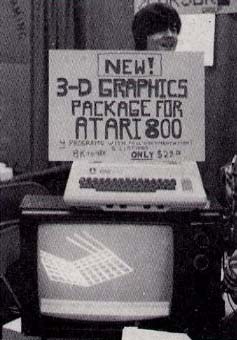Star Raiders and the Atari SOUND Command
Star Raiders

|
|
Photo 1. |
That is the excuse you give the Internal Revenue Service, your accountant, and your husband. Truthfully, the reason you bought your Atari was to play Star Raiders (TM), the most addictive computer game yet developed.
The game comes as a ROM cartridge with a lavishly illustrated twelve page instruction manual at a cost of $59.95. In addition, you need to purchase a joystick, costing $19.95 for two. The joysticks are not sturdy, and get heavy use, so you can use the spare.
Study of the instruction manual takes about 45 minutes and is essential to adequately understand the game. However, if you have someone available who already knows Star Raiders, it can be learned in 5 minutes by demonstration, if the demonstrator will then give up the machine. That brings you to the point of understanding. To truly master the game might take years.
Your mission is to defend your star bases from the Zylon fighters. You do this by locating the enemy on the Galactic Chart, turning on your defense shields, hyperwarping through space to the enemies' sector, and engaging them in combat until the best man, woman, or Zylon wins
You are rated upon your performance based upon the level of play you have chosen, the number of enemy destroyed, the length of time it took you, the number of your starbases that have been destroyed, and the amount of energy you used. Final ratings range from Garbage Scow Captain, class five to Star Commander, class one, with 60 different possible ratings. There are four levels of play, from novice to commander.
The graphics and the sound effects are brilliant. Stars whiz past you, your engines whoosh and your torpedoes explode, your klaxon sounds a red alert, and the enemy fighters speed past you, coming from all angles and all sides, firing their exploding torpedoes. Enemy fighters explode in clouds of blue particles, while the sky flashes red whenever you sustain a hit.
The instrumentation of your ship is also impressive. In addition to your Galactic Chart, which is updated by sub-space radio, your color coded instruments tell you the range to the enemy being tracked on the x, y, and z axis, your velocity, shield status, energy level, the condition of your photon torpedoes, engines, computer, long range scan, and your sub space radio. Your target acquisition computer helps you to steer while hyperwarping through space, as well as indicating the relative position and range to enemy fighters. In addition, upon your request it will shift automatically from forward to aft views from your ship as enemy fighters pass by on attack runs. The joystick allows you to climb, dive, veer right and left, and to combine vertical and horizontal movement, while twenty more keys on the keyboard control speed and function selection.
Star Raiders requires a color monitor or television, as much of the information is color coded and does not show up in black and white. I cannot pin down any definite bugs, although it is often hard to orbit a star base, and I did have a system lockup once in the middle of a game that required me to turn the power off and on again and restart the game.
This game goes beyond the quality of the games you see in video arcades. The sound effects, color, and action are just as good, the physical environment is a bit less impressive, but the real change is the strategy. Since an arcade game must produce $10 an hour in revenue, those games have to be active and short. Grand strategy is not possible. A home computer does not suffer from the same constraint, so the game can actually be better, and Star Raiders is better. The true video arcade addict can justify the purchase of an Atari 400 in a few months of unspent quarters.
If you have an Atari, buy this game! If you don't have an Atari, sell your car (you'll never leave home again anyway), put your children up for adoption so they won't take over the computer, and buy one. Then play Star Raiders until the last stardate fades into the collapse of the universe.
Atari Sound
As a programming feature this month, I'd like to discuss the Atari SOUND command. The format for the sound command is as follows:
SOUND (Voice), (Pitch), (Distortion), (Volume)
You can have up to four voices, or notes, that can be played at the same time, numbered from 0 to 3. Each voice is totally independent of the others.
Pitch can range from 0 to 255, with high C at 29 and low C at 243. Distortion (timbre) can take any even number from 0 to 14. The value 10 gives a pure tone, while other values are used for sound effects. Volume can range from 1, which is hard to hear, to a loud 15. If you are using three or four voices, you should limit the total volume to 32 or less to avoid distortion. To turn the sound off, use the command END or set the volume for that voice to 0.
This program will demonstrate the range of sound available, displaying the value on the screen so that you can note sound effects you would like to use. Really good sound effects will mix several voices.
10 FOR A=0 TO 14 STEP 2 20 FOR B=0 TO 255 30 SOUND 0,B,A,8 40 PRINT "SOUND 0,";B;",";A;",8" 50 FOR C=1 TO 250:NEXT C 60 NEXT B 70 NEXT A
I like SOUND 0,6,0,8:SOUND 1,21,0,8:SOUND 2,27,0,8:SOUND 3,40,0,8 for an explosion, SOUND 0,17,8,8 for a Phaser, SOUND 0,30,8,14 for a gun shot, SOUND 0,70,2,8 for a truck motor, SOUND 0,145,2,(1 to 12 to 1) for an airplane motor, and SOUND 0,12,4,10 for a machine gun, but I am sure you will have your own choices.
Table of Contents
Previous Section: Missile Command & Asteroids
Next Section: Basketball

